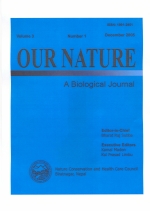Status and Distribution of Blue Sheep, Tibetan Argali and the Kiang in Damodar Kunda Area, Upper Mustang, Nepal
DOI:
https://doi.org/10.3126/on.v3i1.335Keywords:
Conservation, Distribution, Disturbances, StatusAbstract
During September 2003, status and distribution of blue sheep, Tibetan argali and kiang was studied in Damodar Kunda area. A total of twelve days were expended in the field for data collection. Areas suspected for high faunal diversity were visited and searched out using binoculars and Nikon spotting scope. Altogether 395 blue sheep (N=21) were recorded. The percentage of female was comparatively higher (n=116) than the male (n=65), yearling (n=32) and lamb (n=52). The ratio of male to female observed during the survey was 1:2 and the ratio of female to lamb is 2:1 respectively. Mean group size was 18.8 individuals with a density of 5.6/sq. kms. Seventy seven individuals of Tibetan argali (N=4) were recorded. Mean group size is 19.3 individuals with a density of 1.1/sq km. Fifty five individuals of Tibetan wild ass (N=10) were recorded. Mean group size was 5.5 individuals with a density of 0.8/sq. km. Upper Damodar Kunda valley is less disturbed compared to lower valley but most parts are barren and have desert like environment. The disturbances caused by livestock grazing and herders camp have direct impact on the wildlife population of the region.
Key words: Conservation, Distribution, Disturbances, Status
doi:10.3126/on.v3i1.335
Our Nature (2005) 3: 56-62
Downloads
Downloads
How to Cite
Issue
Section
License
This license enables reusers to distribute, remix, adapt, and build upon the material in any medium or format for noncommercial purposes only, and only so long as attribution is given to the creator.




